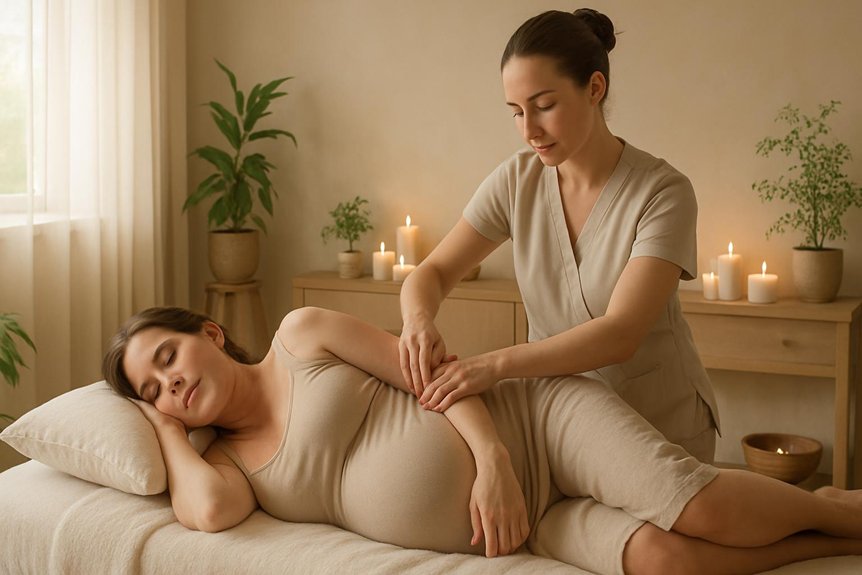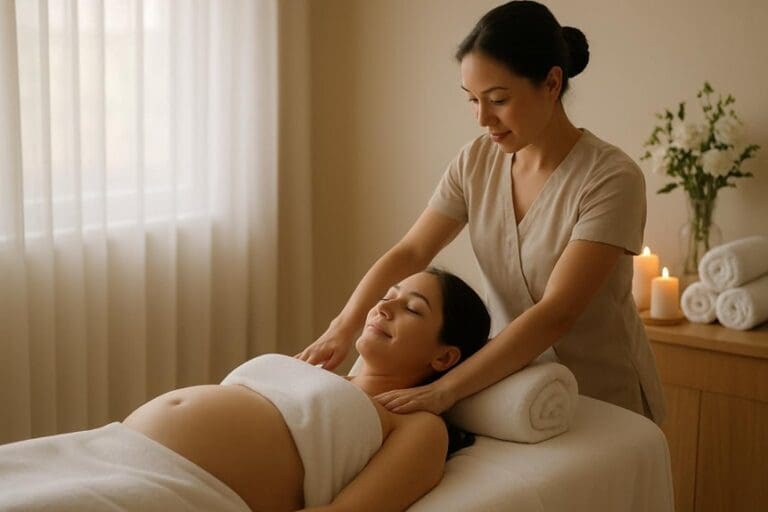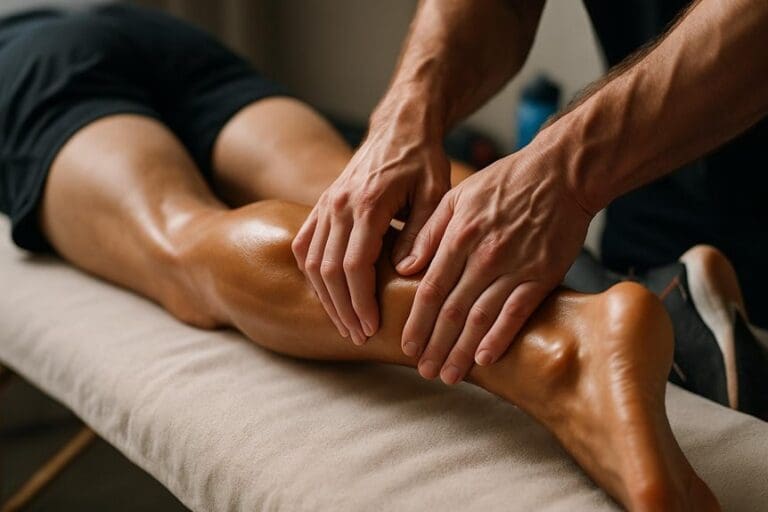Massage during pregnancy can be safe when performed by qualified therapists following clinical prenatal guidelines. Adapted positioning, gentle techniques, and avoidance of high-risk areas—such as the abdomen and inner thighs—are essential. It is recommended to begin massage after the first trimester and only after medical consultation, especially in high-risk or complicated pregnancies. Persistent pain, swelling, or specific symptoms warrant professional evaluation. Further information will clarify the safest methods and timing for prenatal massage.
Understanding Pregnancy Massage: What Makes It Different
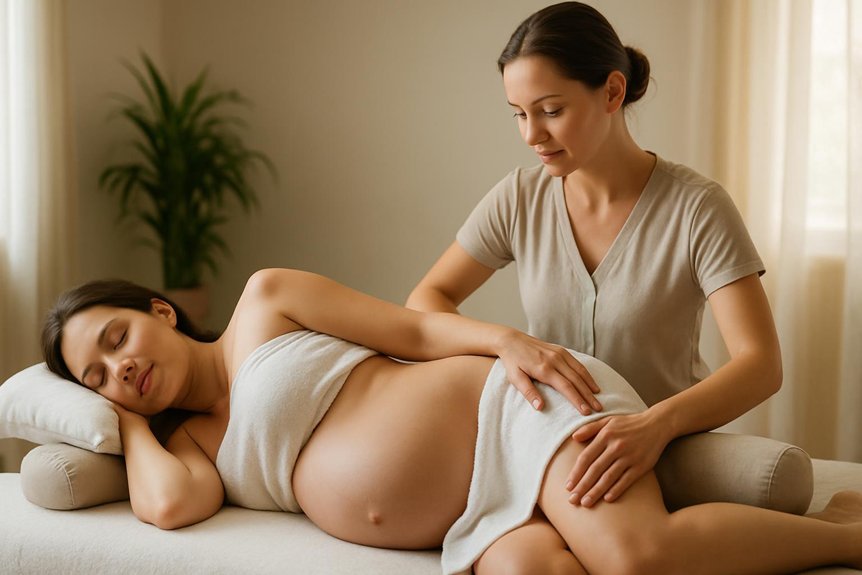
Prenatal massage, as provided at Spa & Massage clinics, is meticulously adapted to address the anatomical and physiological changes unique to expectant mothers. Therapists use specialised positioning, such as side-lying support with pillows, to minimise uterine pressure and optimise maternal-fetal circulation.
Techniques are gentle, avoiding deep tissue manipulation over the lower back, abdomen, and legs to reduce thromboembolic risk. Only pregnancy-safe oils are selected, minimising dermal absorption concerns.
Therapists at Spa & Massage are trained to identify contraindications, such as pre-eclampsia or high-risk pregnancies, ensuring safety above all. This clinical, risk-aware approach allows clients to experience nurturing touch that prioritises maternal comfort and emotional connection, recognising the unique vulnerabilities and needs of pregnancy at every stage. A related approach that also offers gentle benefits during pregnancy is reflexology, which focuses on specific points of the feet and hands to promote relaxation and overall wellbeing for expectant mothers.
Benefits of Massage Therapy for Expectant Mothers
Clinical evidence suggests that massage therapy during pregnancy may assist in alleviating musculoskeletal discomfort, supporting emotional regulation, and enhancing sleep quality.
At Spa & Massage, therapists employ pregnancy-specific techniques designed to minimise risks while promoting physiological and psychological wellbeing. These interventions are tailored to address common gestational concerns, with careful consideration for maternal and fetal safety.
Easing Pregnancy Discomfort
During pregnancy, physiological changes such as increased blood volume, hormonal fluctuations, and musculoskeletal adaptations often lead to discomfort and pain for many expectant mothers. Common complaints include lower back pain, pelvic girdle pain, edema, and muscle tension.
Clinical evidence suggests that appropriately administered prenatal massage can reduce these discomforts by improving circulation, alleviating muscular tension, and supporting lymphatic drainage.
At Spa & Massage clinics, therapists employ side-lying positioning, gentle pressure, and specialised techniques to ensure maternal safety while targeting areas of strain.
Risk assessment is integral; therapists avoid deep abdominal work and adapt sessions based on gestational age and individual needs.
With professional guidance, massage therapy offers tangible relief from physical discomforts, fostering a sense of comfort and connection for both mother and developing baby.
Emotional Wellbeing Support
A significant body of evidence demonstrates that massage therapy can positively influence emotional wellbeing in expectant mothers by modulating stress hormones, reducing anxiety, and enhancing mood stability.
During pregnancy, heightened emotional sensitivity and fluctuating hormone levels can contribute to increased psychological distress. Clinical studies indicate that regular, professionally delivered massage sessions help lower circulating cortisol and elevate serotonin and dopamine, contributing to a more balanced emotional state.
At Spa & Massage, therapists prioritise gentle, supportive techniques tailored to each stage of pregnancy, fostering a sense of security and trust. Clients often report feeling nurtured, valued, and more connected to their pregnancy experience following treatment.
Improving Sleep Quality
Sleep disturbances are frequently reported among pregnant individuals, with increased prevalence of insomnia, nocturnal discomfort, and fragmented sleep cycles associated with physiological and hormonal changes.
Clinical evidence suggests that massage therapy may promote improved sleep quality by reducing musculoskeletal tension, alleviating discomfort, and modulating stress-related hormones such as cortisol.
Within Spa & Massage clinics, therapists employ gentle, pregnancy-safe techniques to address areas of tension commonly contributing to sleep disruption, such as the lower back and hips.
By facilitating parasympathetic nervous system activation, massage supports relaxation, potentially decreasing the time required to fall asleep and enhancing overall sleep duration.
Therapists at Spa & Massage carefully assess each client’s trimester and specific risk factors, ensuring that all interventions prioritise safety, comfort, and advantageous therapeutic benefit for expectant mothers seeking restful nights.
When to Seek Massage During Pregnancy
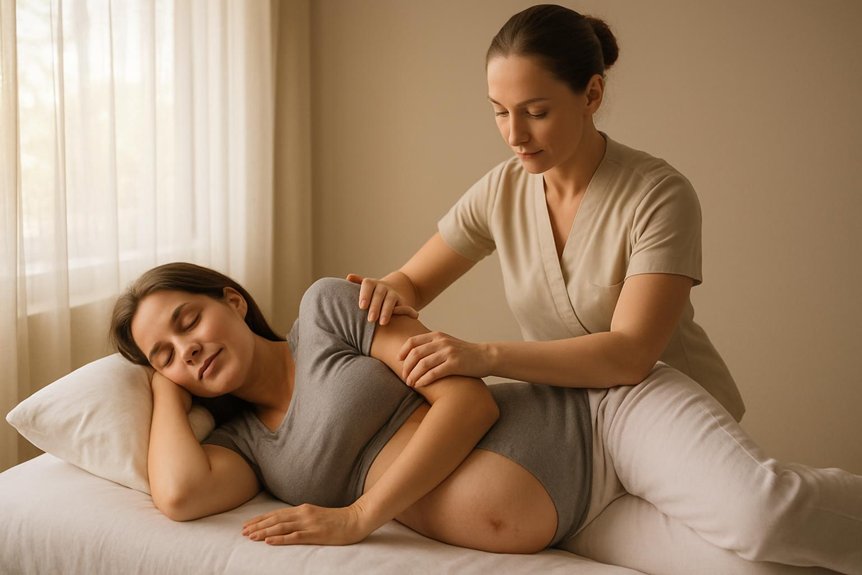
Current clinical guidance suggests that the second and third trimesters are generally considered ideal for initiating massage therapy during pregnancy, as the risk of complications is lower compared to the first trimester.
Pregnant individuals experiencing musculoskeletal discomfort, edema, or stress may benefit from targeted massage interventions, but it is essential to distinguish between normal pregnancy-related aches and symptoms that warrant medical evaluation.
Prior to scheduling a session, Spa & Massage recommends that all expectant mothers consult their healthcare provider to ensure massage therapy is suitable for their specific clinical circumstances.
Optimal Trimester for Massage
While prenatal massage can offer substantial benefits throughout pregnancy, clinical guidance typically advises that massage therapy be sought after the first trimester. This recommendation arises from the increased risk of miscarriage during the initial 12 weeks and the heightened sensitivity of maternal physiology at this stage.
From the second trimester onward, massage is generally considered safe when performed by qualified therapists, such as those at Spa & Massage, who are trained in pregnancy-specific techniques and positioning. During this period, targeted massage can alleviate musculoskeletal discomfort, support circulation, and reduce stress.
At Spa & Massage, therapists carefully adapt each session to accommodate changing anatomy, always prioritising maternal and fetal safety. Clients are encouraged to consult with healthcare providers before commencing prenatal massage to ensure personalised, risk-appropriate care.
Recognising Discomfort or Pain
As pregnancy progresses, individuals may experience a range of musculoskeletal and systemic discomforts, including lower back pain, pelvic pressure, oedema, and muscle tension, which are frequently associated with physiological and hormonal adaptations.
These symptoms, when persistent or intensifying, can interfere with rest, mobility, and emotional well-being. Recognising early signs of discomfort—such as localised pain, aching, or swelling—enables timely intervention.
At Spa & Massage, therapists are trained to identify patterns of musculoskeletal distress that may benefit from targeted prenatal massage, while always prioritising maternal and fetal safety.
Attention to the body’s signals is essential; pain that disrupts daily activities, or swelling beyond mild oedema, warrants professional attention.
Therapeutic touch, when appropriately timed and administered, supports comfort and relaxation throughout the pregnancy journey.
Consulting Your Healthcare Provider
Before initiating massage therapy during pregnancy, medical consultation is strongly advised to assess individual risk factors and underlying health conditions.
Certain complications—such as preeclampsia, gestational diabetes, or a history of preterm labour—may contraindicate or require modifications to massage protocols.
A healthcare provider can offer personalised guidance, ensuring that both maternal and fetal wellbeing remain the paramount.
At Spa & Massage, therapists encourage open communication with obstetricians or midwives before scheduling prenatal massage sessions.
This collaborative approach supports the safest possible experience, tailored to each stage of pregnancy.
Clients are reminded that professional assessment helps identify any emerging concerns and determines the most suitable timing for massage.
Seeking clearance from a trusted provider enhances peace of mind and fosters a nurturing, supportive environment throughout pregnancy.
Safety Guidelines for Prenatal Massage
Although prenatal massage is widely recognised for its therapeutic benefits, strict adherence to safety protocols is essential to minimise potential risks to both mother and fetus.
Current evidence underscores the importance of positioning pregnant clients in a lateral recumbent or semi-reclined posture to avoid aortocaval compression, which may compromise uteroplacental blood flow.
Direct, deep pressure over the abdomen and certain acupressure points—particularly those associated with uterine stimulation—should be avoided.
At Spa & Massage, therapists carefully select hypoallergenic oils and maintain rigorous hygiene standards to reduce the risk of skin sensitivities.
Clear communication regarding gestational age, medical history, and symptoms is vital for risk mitigation.
Ultimately, these safety guidelines foster a nurturing, secure environment, supporting maternal well-being and fetal development throughout pregnancy.
How Our Therapists Tailor Treatments for Pregnant Clients
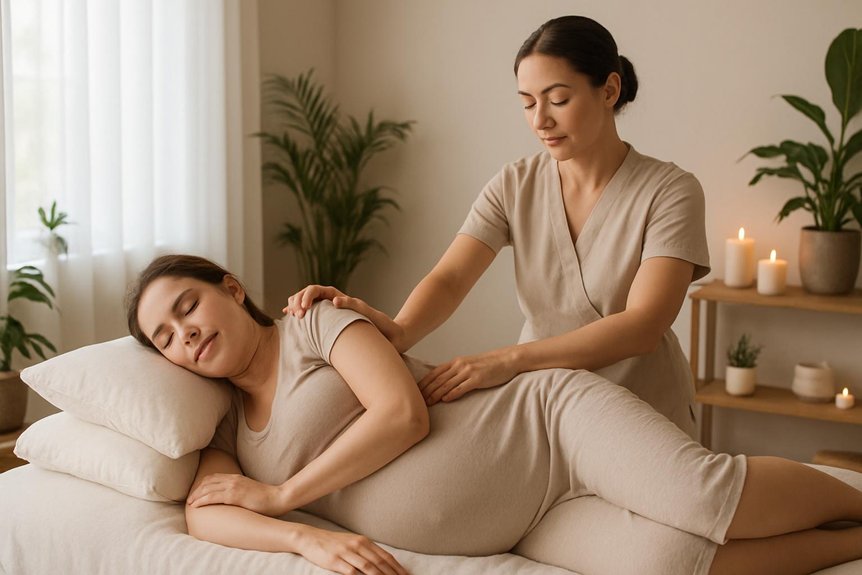
When addressing the needs of pregnant clients, Spa & Massage therapists utilise a thorough assessment protocol that evaluates gestational stage, medical history, and presenting symptoms to individualise each treatment plan. This clinical approach allows therapists to identify potential contraindications and adapt therapeutic interventions accordingly.
Positioning techniques are modified to ensure maternal comfort and reduce vascular compression, particularly after the first trimester. Massage pressure, duration, and modalities are adjusted in response to physiological changes such as increased joint laxity, fluid retention, and altered circulation.
Therapists prioritise open communication, fostering trust and understanding of each client’s preferences and concerns. By integrating clinical expertise with empathetic care, Spa & Massage enhances the safety and effectiveness of prenatal massage, supporting both physical well-being and emotional reassurance throughout pregnancy.
Areas to Avoid and Cautionary Techniques
How does a therapist guarantee safety during prenatal massage?
At Spa & Massage, therapists employ evidence-based protocols to identify anatomical regions requiring caution. Direct pressure is avoided on the abdomen, lower back, and areas with enlarged blood vessels to reduce the risk of vascular compromise.
Deep tissue techniques are contraindicated over the inner thighs due to increased venous stasis and risk of thromboembolism during pregnancy. Gentle effleurage is preferred, prioritising comfort and maternal-fetal wellbeing.
Special consideration is given to acupressure points, particularly around the ankles and wrists, as stimulation may be associated with uterine contractions.
Pillowing and side-lying positions alleviate pressure on the inferior vena cava, optimising circulation and intimacy.
These clinical precautions support both physical safety and emotional reassurance throughout the prenatal experience.
Choosing the Right Type of Massage for Each Trimester
Which massage modalities are ideal during each trimester of pregnancy depends on physiological changes and evolving risk profiles.
In the first trimester, gentle Swedish massage is preferred, minimising deep tissue work to reduce risks associated with vascular changes and heightened miscarriage risk.
As pregnancy progresses into the second trimester, therapists at Spa & Massage adapt techniques to relieve lumbar discomfort and oedema, utilising side-lying positioning for maternal and foetal safety.
During the third trimester, sessions focus on lymphatic drainage and targeted relief for pelvic and lower back strain, while maintaining careful monitoring for signs of preterm labour.
At Spa & Massage, therapists employ unscented, hypoallergenic oils and prioritise open communication, ensuring each treatment is both safe and tailored for nurturing support throughout all stages of pregnancy.
Aftercare and Self-Care Tips Following a Session
A structured aftercare protocol following prenatal massage is critical to optimise physiological benefits and minimise potential risks such as postural hypotension or increased oedema.
Spa & Massage therapists recommend gradual progression from the massage table to a seated position, allowing blood pressure to stabilise. Adequate hydration post-session supports circulatory function and tissue recovery.
Gentle ambulation is encouraged to prevent fluid pooling in the lower extremities. Clients are advised to avoid strenuous activity for several hours, permitting the parasympathetic nervous system to sustain the therapeutic effects.
At Spa & Massage, many clients find that incorporating self-massage techniques and mindful breathing extends relaxation.
Monitoring for adverse symptoms—such as dizziness, headache, or persistent swelling—is essential, and any concerns should be promptly communicated to a healthcare provider or therapist.
Conclusion
In summary, when guided by clinical best practices and executed by trained professionals, prenatal massage can offer significant therapeutic benefit while mitigating risk—echoing the adage of Hippocrates to “first, do no harm.” By adhering to trimester-specific protocols, contraindication screening, and evidence-based techniques, practitioners at Spa & Massage ensure that maternal wellbeing is prioritised. Consequently, informed and judicious application of massage therapy can safely support expectant mothers on their unique journey toward childbirth.
